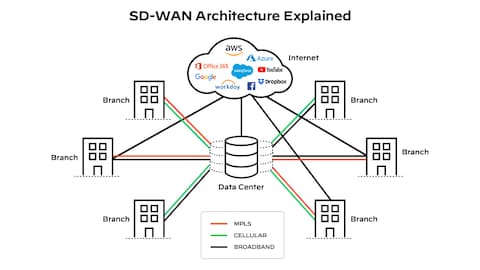SD-WAN enables secure connectivity to networks and cloud applications. It also increases operational bandwidth by routing traffic over various connection types, including LTE, broadband internet, and MPLS. It also helps businesses save money by replacing expensive private MPLS links with less costly public internet connections. This allows IT teams to right-size their network connections on demand based on application needs.
SD-WAN Defined
What is SD-WAN? SD-WAN is a technology that improves the management and operation of wide-area networks. It decouples networking hardware from the control mechanism, allowing for more cost-effective and flexible network connections. SD-WAN technology includes overlay and underlay networks and a centralized controller that makes intelligent route decisions and optimizes traffic. By monitoring the underlying physical links and applying configured policies, SD-WAN ensures optimal application performance across all locations, even during congestion or network instability. Unlike traditional WAN technologies, which backhaul traffic from branch offices to central security points in the data center, SD-WAN routes traffic over multiple network connections (MPLS, broadband internet, LTE, etc.) to keep employees connected no matter the quality of their internet connection or physical location. This helps productivity and eliminates the risk of lost work due to poor connectivity. By deploying an overlay network that utilizes public internet services, SD-WAN enables organizations to offload low-priority traffic from expensive MPLS circuits and reserve those resources for higher-priority applications. Additionally, organizations can reduce reliance on expensive leased lines and lower overall networking costs by incorporating underlay networks that leverage cost-effective private network connections and internet VPNs.
How Does SD-WAN work?
SD-WAN provides a more cost-effective way for enterprises to connect their branch offices to central data centers and SaaS and IaaS applications. It also automates traffic steering in an application-driven way based on business intent, improves network security, and simplifies the WAN architecture. Unlike traditional MPLS circuits, which require dedicated connections that are expensive and slow to deploy, SD-WAN combines multiple links such as broadband, 4G/LTE, and VPN with a virtual overlay decoupled from physical links for greater flexibility. The centralized controller in an SD-WAN solution makes connection decisions between locations based on real-time network conditions and configured policies. An SD-WAN appliance receives connection requests from end-user devices, then sends them to the centralized controller via a secure tunnel. The controller then evaluates the traffic to determine the best path, ensuring high performance and availability. When a link experiences a problem, such as a packet loss or latency, the underlying infrastructure is automatically rerouted around it. In addition, many SD-WAN vendors integrate security features into their hardware and controllers, providing a more unified security approach and simplifying management. Kentik can provide visibility into a company’s SD-WAN, including its overlay and underlay networks and application traffic. This enables NetOps to quickly spot problems such as unauthorized access or network outages and respond with automated remediation.

What Are the Benefits of SD-WAN?
SD-WAN enables companies to deliver business services that exceed the expectations of customers and employees, which can help drive revenue. This is accomplished by allowing the organization to improve performance and reliability, reduce costs, and enable agile working environments. With an automated policy framework propagated from a centralized controller, IT teams can gain visibility into application traffic across the WAN. IT can easily define, control, and change business requirements to ensure WAN connectivity meets business goals and objectives. Companies can save on costly leased lines and overall networking costs by leveraging cost-effective internet connections and VPNs for underlay networks.
Additionally, SD-WAN allows companies to use cheap broadband and mobile 4G links for low-priority traffic, reducing expenses. With a flexible WAN design, SD-WAN reduces latency and increases throughput by routing data over the most efficient route. This provides the best possible user experience for employees at remote sites while ensuring that critical applications receive priority over less important traffic. Dynamic path selection also optimizes bandwidth utilization, reducing costs by directing traffic over links with the lowest available prices. In addition, SD-WAN solutions often integrate security features directly into the edge devices and centralized controller for a more unified security approach.
Are There Any Drawbacks to SD-WAN?
SD-WAN can provide better control and scalability in a sizeable multi-office environment than traditional routing technology. With the ability to utilize multiple types of connections, an SD-WAN router can automatically failover between various mediums. This can reduce overall costs as less sensitive data is sent over the public Internet while critical and mission-critical data is reserved for leased line connections. Additionally, with the centralized management of an SD-WAN solution, there is much lower overhead than with a traditional router. Many companies don’t have the IT resources to manage a full-time team of network specialists at each office location, and a centralized solution makes it easy for these experts to manage every device on the network from one central interface. As a result, this also helps to improve security as it’s harder for hacking devices to get into the system by having the same configuration across all sites.



